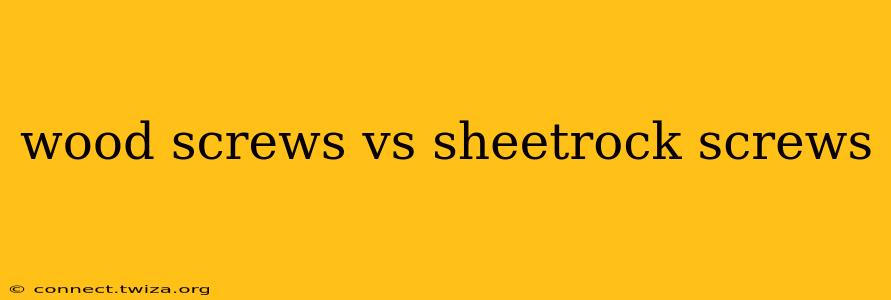Choosing the right screw for your project can seem daunting, especially when faced with the seemingly similar wood screws and sheetrock screws. While both are used for fastening materials, they have distinct differences that make them ideal for specific applications. Understanding these differences is crucial for ensuring a strong, secure, and long-lasting result. This comprehensive guide will break down the key distinctions between wood screws and sheetrock screws, helping you select the perfect fastener for your next project.
What are Wood Screws?
Wood screws are designed for use in wood and other similar materials. Their primary characteristic is a sharp, pointed tip and a relatively coarse thread. This design allows them to easily penetrate wood fibers, creating a strong grip that resists pulling out. Wood screws come in a vast array of sizes, head styles (like flat, pan, round, and oval), and materials (such as steel, brass, and stainless steel). The choice depends entirely on the project and aesthetic preferences.
Strengths of Wood Screws:
- Strong Hold: Their coarse threads create excellent grip and holding power within wood.
- Versatility: Suitable for a wide variety of wood types and thicknesses.
- Aesthetic Appeal: Available in numerous head styles and finishes to match your project's look.
- Ease of Use: Generally easier to drive into wood than sheetrock screws.
What are Sheetrock Screws?
Sheetrock screws, also known as drywall screws, are specifically engineered for fastening drywall to studs. They feature a fine thread and a relatively blunt tip. The fine thread is designed to minimize damage to the drywall paper face and create a secure hold without excessive cracking. The blunt tip helps prevent the screw from splitting the drywall. They typically have a self-tapping design, requiring less pre-drilling than wood screws. They're most commonly available with a fine, slightly recessed pan head.
Strengths of Sheetrock Screws:
- Drywall-Specific Design: Minimizes damage to the drywall surface.
- Efficient Installation: The self-tapping design often eliminates the need for pre-drilling.
- Consistent Performance: Designed for reliable holding power in drywall applications.
Wood Screws vs. Sheetrock Screws: Key Differences Summarized
| Feature | Wood Screw | Sheetrock Screw |
|---|---|---|
| Tip | Sharp, pointed | Blunt |
| Thread | Coarse | Fine |
| Head Style | Varied (flat, pan, round, oval) | Typically fine pan head |
| Application | Wood, other dense materials | Drywall, sheetrock |
| Pre-drilling | Often required (depending on wood) | Often not required |
| Holding Power | High in wood | High in drywall |
What Happens if I Use the Wrong Screw?
Using the wrong type of screw can lead to several problems:
- Stripped Holes: Using wood screws in drywall can easily strip the softer material, resulting in loose screws and a damaged wall.
- Cracked Drywall: Using wood screws in drywall can cause cracks around the screw head.
- Poor Hold: Using sheetrock screws in wood might not provide sufficient holding power, especially under stress.
- Uneven Surface: The wrong head style can leave an unsightly finish.
What type of screw should I use for...?
This is a frequently asked question, and the answer depends on the material. If you are unsure, always err on the side of caution and choose the screw designed for the specific material.
Can I use sheetrock screws in wood?
While technically possible, it's generally not recommended. Sheetrock screws might not provide the same level of holding power as wood screws in wood, especially with hardwoods or thicker pieces. This can lead to screws pulling out over time.
Can I use wood screws in drywall?
Using wood screws in drywall is strongly discouraged. The sharp point and coarse threads can easily damage or split the drywall, leaving unsightly cracks and reducing the structural integrity of the wall.
What about other materials?
For other materials, like metal or plastic, you'll need screws specifically designed for those materials. These materials require different thread profiles and screw types to achieve proper fastening.
By understanding the nuances of wood screws and sheetrock screws, you can ensure that your projects are built to last. Remember to choose the right screw for the job to achieve the best possible results and avoid costly mistakes.
